| Title | Platform/Version | Time to Beat | Achiev % |
|---|---|---|---|
| Final Fantasy V | PC (Pixel Remaster) | 32 Hours | 100% |
| Used Modifications: – Pixel Text Replacement – Playstation Button Replacement – 2x Speed modification (to assist in mindless grinding) |
Intro – Home Sweet Home
Final Fantasy V was originally released in 1992, the third Final Fantasy in as many years by Square. Like Final Fantasy II and III, this game was chosen not to be localized outside of Japan until 1999 with the NA release of Final Fantasy Anthology for the Sony PlayStation, which for me was the first time I personally played the game. Outside of watching a friend play through the game in 2003, this would be my only playthrough of FFV and while I remembered it fondly before this playthrough, there were many specific aspects that I had completely forgotten about.
FFV was spiritually a true successor to FFIII, and in many ways is the game that first fully embraced Final Fantasy as a flagship. This was the first time that choices seemed to be made to pay direct homage to earlier entries, while also expanding and exploring new ideas at the same time. The popular Job System from FFIII returned, only to be further enhanced to give the player even more agency.
Additionally, with a return to a (mostly) static 4-person party and the addition of some of the strongest worldbuilding the series had yet seen, Square had a recipe for success in making a deep, approachable, and thoroughly enjoyable entry in the series.
Whimsical vs Cinematic
When I originally introduced the concept of “Whimsical” vs “Cinematic” back in my review of Final Fantasy III, I had mentioned that I felt that Final Fantasy V was a game that attempted to be both. I had made this comment based on my memories of my time with the game back when I last played it in 2003. Now, with fresh eyes and this recent completionist playthrough, I feel that the game truly does lean more Whimsical than Cinematic. There are heavy themes for sure, however more often than not FFV presents a story and a tone that is lighthearted and overflowing with opportunities for you to smile and laugh. That being said, this doesn’t make the story beats any less impactful, and the game truly pulled on my heartstrings twice, leading to the first time I’ve shed tears during my revisit of these games.
This game was everything I remembered and then so much more. Revisiting this story and these characters as a man nearing his 40’s has given me new perspective and it has only made me adore this game more.
The Gameplay
So, the gameplay here is largely just a fine tuning of the gameplay of FFIV with the additional layer of the customization of the Job System in FFIII. The one key difference however, is that in this game, you can mix and match abilities from multiple jobs. So, you can train one of your characters as a Monk, for example, which gives them the ability “Barehanded”. Then, you can change that character into a White Mage to be your party healer, and give them the “Barehanded” ability, which makes their attacks without a weapon hit as hard as a Monks.
You can have a Knight who knows Time Magic, or a Summoner who shoots arrows, or pretty much any other combination you can imagine. There are 22 jobs, 20 of which have multiple abilities to learn, and you can mix and match them as you wish to construct a party that is truly unique to your tastes. Additionally, 2 of the jobs (Freelancer and Mime) have access to ALL abilities from those jobs you’ve mastered on that character. Playing normally, you may master 2-3 jobs by the end game, but to tackle the optional super bosses, you’ll likely master most if not all jobs on all characters, making Freelancer and Mime INCREDIBLY strong late game, as they get to mix and match from ANY job and get the cumulative passive abilities of them all.
Aside from the job system, FFV was also the first entry that truly had significant optional content and puzzles in its dungeons. The dungeons in particular, although still relatively linear, were a delight to explore, each with little hidden passages and missable items/chests if you couldn’t figure out the puzzle or mechanic for the dungeon. It’s little things like this that really breathed life into this game and brought the inner child out of me. I seriously had a blast just playing this game.
The Story
Now that I’m starting to get to the entries of the series that have significant story elements, from here on out this section will be broken up by act, so I can speak to the plusses and negatives of each part.
As a general introduction to FFV, the premise is somewhat simple. Our heroes are a ragtag bunch of do-gooders who need to travel the world to stop the crystals from being destroyed. Unlike FFI and FFIII which start with the same premise, FFV actually spends time setting things up. We get an extended opening cinematic with Lenna, the princess of Tycoon, begging her father the king to not investigate the fading wind crystal. After he leaves, the wind stops completely, and Lenna sets out to the wind palace to investigate and help.
Then, a meteor lands in the forest she’s passing through. This is where we are introduced to Galuf and Bartz. Bartz is a wandering mercenary who just so happened to be traveling through the forest with his chocobo, Boko. Galuf is an old man that was injured when the Meteor crashed, and due to the injury, he has amnesia. Lenna tells the two that she needs to get to the wind crystal, and Galuf immediately offers his assistance to repay her for helping him with his injury. Bartz initially rejects the hero’s journey, but then shortly after decides to follow them. Thus begins our journey!
Act 1 – The Call of the Crystals
Our party travels through a cave to get to the palace of wind, which turns out to be a pirate den. What starts as an attempt to steal the ship from under the noses of the pirates quickly turns into a request to commandeer the ship from Faris, the pirate lord. This doesn’t work, and Faris throws the characters in the brig. Then, it turns out that Faris has some sort of connection to Lenna (they share a matching necklace), so Faris lets the party out and offers to lend them his ship, since it’s the only ship that works now that the wind has stopped blowing, due to being pulled by Faris’ pet sea dragon, Syldra.
Faris joins the party, and we march to the temple of Wind where we get there too late to stop the crystal of wind from exploding. We get some exposition where an image of the King of Tycoon informs us that we have a destiny as the four heroes of light, and we must protect the remaining crystals. The party races to the second crystal but experience a massive whirlpool that devours Syldra and leaves them adrift in the sea, before dumping them in a ship graveyard. It’s here that we finally come to terms with who Faris is.
Halfway through the ship graveyard, the party decides to take a break, get out of their soaking wet clothes, and stop for the night. Lenna goes into another room to change clothes, meanwhile Bartz, Galuf, and Faris begin changing in the main room. Faris refuses to get undressed and then one thing leads to another, and we find out that Faris is biologically female, and was only presenting as male due to being raised by pirates. This scene is largely played for laughs similar to other crossdressing scenes in other media of the 80’s and 90’s, think Tootsie, Mrs. Doubtfire, and The Birdcage. However, it’s also full of heart, leading to the party now fully accepting Faris into the group, referring to them as “she” for the rest of the adventure.
On Faris…
An Important, Forgotten Page in the History of Trans Representation
I just wanted to take a moment to mention exactly how much Faris’ character stood out to me as being out of place and super progressive given the early 90’s. Faris presents primarily as Male due to their pirate upbringing but ends up being more what we now call non-gender-conforming. While the party refers to Faris as “He” until the early reveal of their true sex, and then “She” afterwards, it remains abundantly clear how uncomfortable Faris is when forced into the female gender stereotypes further explored in later acts.
While this aspect of Faris is not heavily focused on, it remains ever-present and informs every word of dialogue spoken, even leading to custom sprite work used to convey how uncomfortable Faris is in a dress when they are asked to take their place as one of the two princesses of Tycoon in Act 3. Despite it not being super heavy in the plot, this aspect of the character is still handled with wonderful tact. The other party members are immediately supportive and accepting of Faris once they reveal the truth, and they don’t bat an eye when Faris later rejects the destiny of being a princess to instead save the world.





Basically, Faris is a hero first. A friend first. A HUMAN first. And this impacted me greatly even when the game showed flashbacks of their childhood, of how Faris was “big sis” to Lenna… and those feelings of sibling bonds are just as strong as any other I’ve seen in media.
Soon after losing their ship and learning of Faris’s true identity (the missing daughter of King Tycoon, and Lenna’s long lost big sister), we continue our journey. We save Hiryu, the Wind Drake from Tycoon and Lenna’s childhood pet to unlock the ability to fly around the inner parts of the world, allowing us to finally get to the second crystal: Walse’s Water Crystal.
Upon our arrival in Walse, we learn that another meteor fell near the tower. When we investigate, we find that a knight wearing weird armor is in the tower, defending the crystal from a crazed monster. We do our best to fight the monster, but it kills the knight and destroys the crystal before we can intervene. The knight, in his dying words, mentions that he knows Galuf and calls him “Lord”, apologizing to the old man before dying.
The Water Tower crumbles into the sea upon the destruction of the crystal, with the party stuck inside it. They almost drown before being rescued by a wounded-but-not-yet-dead Syldra, who takes them back to dry land. Syldra’s final act leads to the actual onscreen death of the sea drake and a pivotal moment of loss for our party. Mired in our defeats and losses, we march on to Karnak to save the Fire Crystal.
The second half of Act 2 has our team reaching Karnak and finding the source of the destruction of the crystals. Years ago, an ancient book told of wondrous power being capable from the crystals, so a brilliant engineer from Karnak, Cid, created a machine to extract the power. This extraction catapulted society to unprecedented comfort and drove wondrous technological advancement, but it also caused the crystals to become weak and eventually collapse. It’s not difficult to see the theming here, the allusions to humanities use of fossil fuels for advancement, and our hubris that is leading to the destruction of our planet.
Well Cid is a man of regrets, but also a man of action. And that’s why we first meet him in jail, where he was put after he attempted to dismantle his machine to save the Fire Crystal. Apparently, Karnak has gotten filthy rich off of making weapons and armor and fancy ships from the forges fueled by the Fire Crystal and weren’t about to lose all of that just to “save the planet”. We bust out with Cid but once again are too late to save the crystal, which this time was being sabotaged by the actual Queen of Karnak, who was under the control of a mysterious evil entity. Despite Cid regretting being a part of the current shitty world situation, we give him a peptalk and he helps us reach the last crystal: The Earth Crystal, buried deep in the Ronkan Ruins.
Along the way, Galuf regains some of his memories! The old bastard reveals that he is actually not of this world, but instead a guardian of the crystals from another world. He traveled here on his meteor, same as the knight we ran into in the Water Tower. He doesn’t remember everything, but he knows that an entity known as “Exdeath” is sealed by the crystals and is likely the evil force behind all of the sabotage of the crystals.
With renewed fervor, we race to the Ronkan Ruins to protect the last crystal. But once we get there, it turns out that the ruins were a part of some ancient machinery that lift into the sky and become a floating sky fortress. We procure an airship and make for the final crystal but alas are once again too late. The possessed body of the King of Tycoon, now revealed to be a vessel for Exdeath, sacrifices itself causing the destruction of the crystal. Suddenly, another meteor lands nearby and a young girl rushes in to whisk the party away to safety as the flying fortress plummets to the ground.
The girl reveals herself to be Krile, Galuf’s granddaughter, also from the other world. Krile’s appearance returns the rest of Galuf’s memories: 30 years ago, he and 3 other warriors known as the “Dawn Warriors” battled Exdeath on their world. Exdeath fled to this world, where the Dawn Warriors took an opportunity to seal him away using the power of the four crystals. Now that Exdeath is freed, he will return to Galuf’s world to finish what he started, something that Krile and Galuf cannot stand to see happen. With tears in their eyes, the party wishes Galuf well as he returns home to his world with Krile, a one-way trip that would mean they’d never see Bartz, Faris, and Lenna ever again.
The first act ends as the party bums around the world coming to terms with their failures before making the decision that Galuf has become their friend, and that their failure to protect the crystals means that they are responsible for helping Galuf to defeat this monster on his world. With great trepidation and anxiety, Bartz, Lenna, and Faris decide that the fate of Galuf’s world is more important than their connection to this one, so they follow behind Galuf using the last of the energies from the remaining meteorites. A one-way trip to a foreign world to help a friend. ; _ ;
Act 2 – A Home Away from Home
Upon warping to Galuf’s world, the party is immediately captured by minions of Exdeath, leading to a great sequence where we see Bartz, Lenna, and Faris held hostage by Exdeath. He uses magic to send a message to the armies marching on his castle, led by Galuf, to surrender if they want the party to live. This is such a great inversion of tropes, as once again our hubris, our decision to follow Galuf to his world to help him, even when he explicitly told us not to, blows up in our face. Our plan was to show up and save the day, but instead we become victims of the villain and the very bonds we share with Galuf that led us to forever abandon our own world to save his are used against him as he also will not see us killed if he can avoid it.
Then, the game does something great, we see Galuf jump on a wind drake and fly solo into Exdeath’s Castle, and the old man does a one-man rescue mission. This is done so well, even culminating in a boss fight against Gilgamesh, Exdeath’s minion. We truly believe that Galuf is the Dawn Warrior of eld, and while he is now an old man, he’s still got plenty of “hero” left in him.
The rescue attempt culminates with the Battle at the Big Bridge… which is literally just a big bridge that connects Exdeaths castle to the rest of Galufs world. Our party is escaping hastily, fighting through wave after wave of Exdeaths minions, finally ending with another battle with Gilgamesh.
Gilgamesh, by the way, is a special, special character in this game. A marriage of ideas by the game’s creators, combining the mythology of the Yojimbo with the traditional Japanese mythological figure Benkei and his seven weapons. Gilgamesh’s personality is borderline fourth wall breaking, with his lines and attitude sounding more like a comical 80’s action movie henchman (with one-liners to boot) than a character in a JRPG. This creative decision and his incredible popularity with fans led to him becoming a recurring character throughout the series. Unlike other recurring elements in Final Fantasy games (Bahamut, Chocobos, Moogles, etc), Gilgamesh is widely considered to be one single character that is cursed to travel through dimensions, leading each iteration to simply be the same Gilgamesh, just in a different point of space and time. This is made pseudo canon due to the resolution of his story in this game, which has him being sucked into the void to forever “wander the rift”. In many ways, Gilgamesh is the only true connection in canon between the primary games, which is solidified by the recurring use of his Battle on the Big Bridge theme (see The Music Highlights below) in each of his appearances across the franchise.
After chasing Gilgamesh off, the party travels across Galuf’s world doing some side missions and helping the remaining Dawn Warriors. We meet Kelger, the werewolf member of the Dawn warriors, who challenges Bartz to a duel and uses his special attack despite Galuf’s warnings. However, Bartz counters the attack, which surprises all and impresses Kelger. When pressed on how he learned to be such a strong warrior, Bartz mentions his father, and it comes to light that Bartz’s father, Dorgann, was actually the fourth member of the Dawn Warriors! Dorgann had stayed behind 30 years ago when they sealed Exdeath away and fell in love with a woman named Stella. They gave birth to Bartz, making Bartz a child of both worlds. This piece of information finally brings Bartz’s character arc full circle as he’s given renewed vision and purpose, as well as giving him answers to who his father truly was.
Working with Krile and the other forces of the planet, the party seeks the wisdom of the ancient sage, Ghido, who reveals who Exdeath TRULY is: A tree. Yes haha, but I promise it’s actually pretty good worldbuilding. On Galuf’s planet, there was an ancient forest whose trees were sentient. In this forest was a great tree that was used as a prison for hundreds of years to seal away evil souls. Well, eventually those evil souls manifested within the tree, corrupting it and transforming it into the entity known as Exdeath. I truly think this makes Exdeath one of the scariest villains in the entire franchise, as he is more a force of nature, an unknowable, unreasonable being comprised of the malice of hundreds of years of evil souls. It’s downright Lovecraftian!
We go to Exdeaths birthplace and after an encounter with the four corrupted crystals of this world, we face off against Exdeath himself. He turns the released power of the crystals against us, and just as things are looking like we have no chance, Krile comes once again to the rescue. However, Exdeath is fully powered now, and he quickly subdues Krile, leading Galuf to lose his cool for the last time. In an epic, powerful scene, Galuf fights back against Exdeath, and by the strength of his resolve alone battles the creature until it has to flee. Galuf wins, but at the cost of the last of his energy, and in an emotional climax to act two, Galuf passes away, leaving his powers and belongings to Krile to finish the job he started.
As an aside, I wanted to point to this moment as being very special upon first playthrough. All of the previous games have either been locked at four characters, or had a rotating cast of characters. Up until this point, it was very clear that FFV was one of the games that was only going to have four characters, and the story benefitted greatly from this focus. For this reason, the death of one of these characters was a HUGE blow to me. Even knowing it was coming, it still impacted me. Krile at this point had been well introduced, but we didn’t feel nearly the attachment to her as we did to Galuf, and it makes the transition a difficult one. Luckily, the game does acknowledge this. Krile doesn’t want this responsibility, she doesn’t feel like “one of the gang”, and this is a theme that would continue well into the epilogue after the end of the game.
Regardless, after the passing of the mantle to Krile, the party decides enough is enough and it’s time to march on Exdeaths castle to get revenge for Galuf and all of the other victims of Exdeaths villainy. After a long dungeon made of flesh and bones, we reach the top and and yet another fight with Gilgamesh. This time, Gilgy shows up with a brand new weapon, the “Excalipoor”, which tickles when it attacks the party and is played entirely for laughs. After the battle, Exdeath banishes Gilgamesh to the void for being incompetent, and the party loots the Excalipoor (which is also a dogshit weapon and is essentially only added to your inventory as a joke). Then, we face off with Exdeath. In his dying throws, he mentions that we’re too late, and that he’s going to return the planet to it’s original state. Whatever that means…
Then, we are knocked out and we wake up… in the fields outside of Tycoon! On our planet! With Krile in tow, the party goes home as victors. Roll credits, right?
Act 3 – And Then All Were One
Wrong.
When Exdeath mentioned “returning the planet to its original state”, what he meant was merging the two worlds. And that’s exactly what he did.
I cannot stress this enough… this element of the story is fucking FANTASTIC. Later FF games would play with having multiple worlds, and/or versions of worlds to travel, but none would go to this depth ever again. It turns out that 1000 years ago, there was another villain named Enuo that created a great void. This void was dangerous, and Enuo was evil, so 12 heroes killed him using legendary weapons. But the void still existed, so great and powerful magic was used to split the world into two parralel dimensions, sealing the void in between. Fast forward to Exdeaths creation, he knew of the void and wanted to use it to destroy all of reality. But to unseal the void, he had to merge the two worlds again. So that’s what he did.
The way the game is designed, you can literally lay the map for the first world on top of the map for the second world to get the third world, or the “merged world” as it’s called in the fandom. The coolest thing about this is that there are areas that the game TEASES you about along the way. Towers and shrines hidden behind mountains that you can never reach on each of these worlds. But now that the worlds are merged, new paths appear, plains from one world overwrite the mountains on the other, or in in one case, literally a bridge from one world leads to a previously locked landmass on the other. It’s only in this merged world that all of the design decisions make sense. And it’s wonderful to see, and I feel as an indie game designer, appreciate, because they designed both worlds to have their own story, to be fully traversable (outside of these few locked away locations), and to FLOW with the linear story. Then, in the merged world, everything opens up, and you are basically given free reign to play in this new big playground. It’s like that moment in a metroidvania game where you get a powerup that makes you go “AHA!” and unlocks entire areas of the map… it feels like that, but from a STORY perspective. It’s just GREAT stuff.
Anyways, Exdeath of course isn’t dead… he’s a primevil force, and he literally traveled with us to the third world via a transformation into a splinter in Kriles foot. Yes, really! Once he manifests again, the party puts aside their reunion tour of their home world and zoom off to the void in their airship to take the battle to the evil tree once and for all. The story in act three is pretty light, however, this is due to most of it being optional content. See Extras and Achievements below for more of a breakdown of all of the events of act 3.
Extras & Achievements
Okay, I just HAVE to gush a little right now about Final Fantasy V’s optional content. After the relatively linear and bare extra offerings in the first four games of the series, FFV blows the doors wide open and gives the player immense agency to explore optional content in its third act.
Once the worlds are merged and the party is reunited in Act 3, the player is given the option to immediately fly their airship into the void and challenge Exdeath. At this point, the characters JUST reunited, and they have only unlocked three of the twelve legendary weapons locked in Kuza, the Sealed Castle. However, they’ve also been given a hint on how to prepare for the fight with Exdeath by chasing down numerous weapons, spells, and summons that are all optional:
- Remaining Sealed Weapons
- What is says on the tin. You get the first tablet (and thus, the first three weapons) as a part of the mandatory story, but the remaining nine weapons require unlocking with the three remaining tablets.
- These weapons are a MASSIVE upgrade over the other weapons available, and their impact is FELT in combat. You feel awesome when your character hits for 40% more damage than before using the new weapons.
- Syldra
- If you remember from Act 1, Syldra is the sea dragon that Faris bonded with and who was pulling the ship after the Air stopped. Syldra died protecting the party during the collapse of the Walse tower when the party received the Water Crystal in act 1.
- Now that we have Krile in the party, her connection with animals and spirits allows you to visit the spirit of Syldra in the Pirates Cove in the merged world. You get an emotional scene between Krile, Syldra, and Faris, and then Syldra is unlocked as a Summon spell.
- The Island Shrine – Tablet 2
- The shrine that was inaccessible from the first world is now accessed via the Big Bridge from the second world now that the worlds have merged. The Island Shrine is a pretty linear but difficult dungeon that leads to the second Legendary Tablet and also removes the barrier around the Fork Tower.
- The Fork Tower
- A special dungeon that is comprised of two towers that have to be climbed at the same time, as the magics at the top of the towers (the spells Holy and Flare, respectively) must be grabbed at the same time otherwise the other will be lost.
- This is accomplished by splitting your party (a first for the series, an element that would be done much heavier in this games successor, FFVI). One tower is Physical Focused with the monsters all reflecting spells, and the other Tower is Magical focused with monsters with high physical defense. So, you have to complete both mini dungeons with half your party, and you have to customize their Jobs to best tackle the needs of the tower you sent each person to.
- Holy and Flare, much like the sealed weapons, are IMMENSELY powerful, and are a significant jump in power for your Black Mage and White Mage casters in your party.
- Furthermore, finishing the Fork Tower reunites you with Cid who upgrades your airship to a submarine, unlocking… access to Istory Falls and the Great Sea Trench
- Istory Falls – Tablet 3
- A dungeon found behind the rushing waters of Istory Falls, leading to the third Tablet AND a battle with Leviathan, which grants you access to him as a Summon.
- Also features a super rare monster fight against Tonberry, the first time this iconic monster would appear in the series. Seriously this took me like 45 minutes to trigger and was worth it. Knifey boy is <3.
- The Great Sea Trench – Tablet 4
- Found literally in the middle of the ocean, this massive dungeon has multiple parts, features ultra hard enemies, lava floors, and contains the fourth and final tablet to unlock the last of the legendary weapons. Additionally, the party also finds the spell Meteor, which is akin to Flare or Holy but for Time Mages (and already an epic spell from the history of the game).
- Halfway through this dungeon, the party finds a settlement of Dwarves, the first time they are shown in the game, and are shown a map that reveals a location in a forest in the middle of nowhere to check out. This leads the player to the Phantom Village.
- The Phantom Village
- A village that is linked with the Void, it was frozen in time until the merging of the worlds and the release of the void. Here, the party get access to the final Piano (allowing them to unlock the final Bard song, which buffs the entire party’s stats), the best buyable gear in the game, AND they come across their Black Chocobo from back in Act 1.
- Jumping on the black chocobo allows you to visit a portion of the world that was inaccessible by airship: North Mountain and Phoenix Tower.
- North Mountain
- This is the same North Mountain from Act 1, however now that the worlds have merged it is now inaccessible except via black chocobo due to the wilds surrounding it.
- Earlier in act three, the party find the first Tablet in the Pyramid of Moore, which unleashes Bahamut into the world. Bahamut has made North Mountain his nest and defeating him here will unlock him as the ultimate summon in the game.
- Phoenix Tower
- Found near North Mountain in a great desert inaccessible by airships, phoenix tower is a 30-floor dungeon filled with difficult enemies and traps. At the top of tower awaits Hiryu, Lenna’s wind drake which has been a big part of the story up to this point, even having saved Lenna’s life when she was brainwashed by Exdeath.
- Hiryu sacrifices himself for the party, and is reborn using the magic of Phoenix Tower into the ultra powerful summon, Phoenix (a first time appearance in the series for the summon).
- This moment is a tear-jerker. ;_; Hug your pets folks.
- The Void
- Okay, so now that all the above is done, you’ve got all the hidden summons, spells, and ultra powerful weapons that the merged world has to offer. HOWEVER, the final dungeon still holds three more important pieces of optional content.
- Superboss Omega. A throwback to Warmech and Iron Giant from FFI and FFII, this time the super boss is walking around and visible on the map screen, so no more grinding for an ultra rare encounter chance. Omega is THE original badass super boss, setting the stage for what would become a series tradition for having ultra difficult optional bosses that are actually a complete challenge unto themselves. This boss is NOT possible to defeat without extensive planning and meticulous party composition. Omega took me three tries, and that was even with a guide.
- Superboss Shinryu. Also uber difficult, Shinryu is found in one of the last Treasure Chests in the game as a “monster-in-a-box”. I didn’t have as much trouble with Shinryu, as I fought him after having maxed out all my characters’ jobs for one of the achievements. Still was spicy though, as it is entirely possible for Shinryu to wipe out the party with a single attack.
- Optional Boss Necrophobe. This boss is not very difficult at all, particularly if encountered after Omega and Shinryu. The fight is EPIC though, as it sees the return of GILGAMESH, however this time he is your friend and fights WITH you against the boss. In the end, Gilgamesh ends up self-destructing himself and the boss before disappearing into the void. This scene unlocks a save point right before the final boss, gives closure for Gilgamesh’s story, and gives the player a satisfying scene full of levity before the heaviness of the ending.
- Okay, so now that all the above is done, you’ve got all the hidden summons, spells, and ultra powerful weapons that the merged world has to offer. HOWEVER, the final dungeon still holds three more important pieces of optional content.
Aside from all the optional content, FFV’s Pixel Remaster featured the standard set of achievements that were difficult in previous editions: Unlocking all chests, Finding all hidden items, and fighting all enemies. In particular, this title is VERY difficult in this regard, as certain enemies, items, and chests become forever locked after each act due to the changing of worlds.
Aside from those three, the most difficult achievement was simply a time-consuming one. Grinding all characters to max job level on all jobs. While this was a little painful, I enjoyed it more than grinding the Princess Flans in FFIV for the Adamant Armor, and furthermore I don’t think I would have been able to beat Omega and Shinryu (also achievements) without having done it. That being said, even at the most efficient spot, this was a 3-4 hour ordeal at the end of the game and I watched a lot of YouTube while doing it, hahaha.

The Music Highlights
I won’t go nuts here, but I wanted to point out a few songs that really stood out to me/are important for the franchise going forward.
The soundtrack to this game sounds like something out of a fairytale epic, but as would become signature for the series, there are a few songs that stand out for emphasis and use other styles. This is the first game of the series that truly leaned into prog-rock as a heavy influence.
My Home, Sweet Home
This song, I feel like more than any other, is what ties all of the theming of this game together. My Home, Sweet Home plays in Bartz’s hometown, but if you listen, you’ll find that this doesn’t sound like a traditional happy town song. This song carries the weight Bartz feels, his frustration and confusion over his own past, and the uncertainty of the future. By this point in the game, the party is heavily on their journey and starting to unravel the mysteries of the world. The song is full of ominous anticipation and there is a melancholy element that makes this piece somber and beautiful and heart wrenching all at once.
To the North Mountain
This song plays during its namesake, North Mountain, and also in Act II in Dragonvale. To the North Mountain uses ROCK ORGAN and sounds like it could have been an instrumental piece played by Yes in the 70’s.
Battle on the Big Bridge
This. Song.
Battle on the Big Bridge is a complete prog rock/math rock EPIC that set the tone for all boss fight themes going forward. While this song is named for “Big Bridge”, a location in world two, it’s been memorialized forever as Gilgamesh’s theme, and in all the other games he appears in (and there are many), there’s always a rendition of this song. This is probably in my top 3 favorite FF songs of all time. It’s so good. SO. GOOD. Jesus. Just listening to it while I write this…. fuuuuuuck. #chefskiss
Dear Friends
During the ending credits, Krile writes a letter to her “Dear Friends” detailing what has happened since the fight with Exdeath. This song plays exclusively during this sequence as Krile does her best to figure out her place in this new world, after losing so much and feeling immense loneliness. Dear Friends as a song feels like the thematic “answer” to the above My Home, Sweet Home. It is more hopeful, but also more wistful. The uncertainty is replaced with regret and the wishes for better times. The song sets up the short epilogue in the games ending perfectly and captures the complex emotions of Krile, a character that doesn’t get nearly enough development time in the game proper.
Final Fantasy Staples Introduced
(Please note that this is not supposed to be an exhaustive list, just those things that I personally noticed and took note of during my playthrough)
- First appearance of the Jobs:
- Blue Mage (!!!)
- Berserker
- Mystic Knight
- Time Mage (!!!)
- Beast Master
- Dancer (!)
- Samurai (!!)
- Chemist
- Mime (!!!)
- First musically timed “real-time” cutscene (opening, the stopping of the wind, the introduction to the four heroes)
- First appearance of “Boko” the Chocobo (frequent name for Chocobos in future installments)
- First appearance of Gilgamesh! <3
- First use of the song “Battle at the Big Bridge“, widely considered the original “epic” Final Fantasy Theme. Seriously, this shit is I C O N I C.
- Important song – “Dear Friends“, plays during the ending. This song would spawn a concert of Final Fantasy music that toured briefly in the early 2000’s and has become iconic.
- First appearance of staple magic:
- Blue Magic in general
- Famously, the “Level” spells. “Level 5 Doom” for example, which affects monsters and party members whose level is divisible by 5.
- Also the two most iconic Blue Magic spells: White Wind and Mighty Guard.
- Quick (instantly take another turn)
- Banish (also called Warp, Dezone, X-Zone, Degen, or Return)
- Phoenix Summon
- Carbuncle Summon
- Blue Magic in general
- First appearance of staple monsters:
Final Thoughts & Score
My playthrough of this entry was… special. I had forgotten so many little nuances, and now approaching the game with the experiences of nearly 20 years of adulthood, many themes that didn’t impact me as a teenager hit home strongly here.
Is the plot still cliche? Yes, largely. Are the characters truly deep and nuanced? Not as much as I would like. But for an SNES game, and particularly a game that had enormous shoes to fill after following FFIV, FFV found a way to both be true to itself, to the series as a whole, while also becoming it’s own thing entirely. The most negative thing to say about this game is that it may have just tried to do too much, without expanding deeper into what was already there. Still, this game is a DELIGHT. I laughed, I cried, and I was moved.
I also want to say that for the first time since starting this project, I found myself actually having fun. Not that the other games haven’t been enjoyable, but I was able to stay very focused on approaching them all academically, where FFV instead invited me to become that teenager again, sitting on the carpet two feet from an ancient CRT TV, awash in the glow of the pixels dancing well into the night.






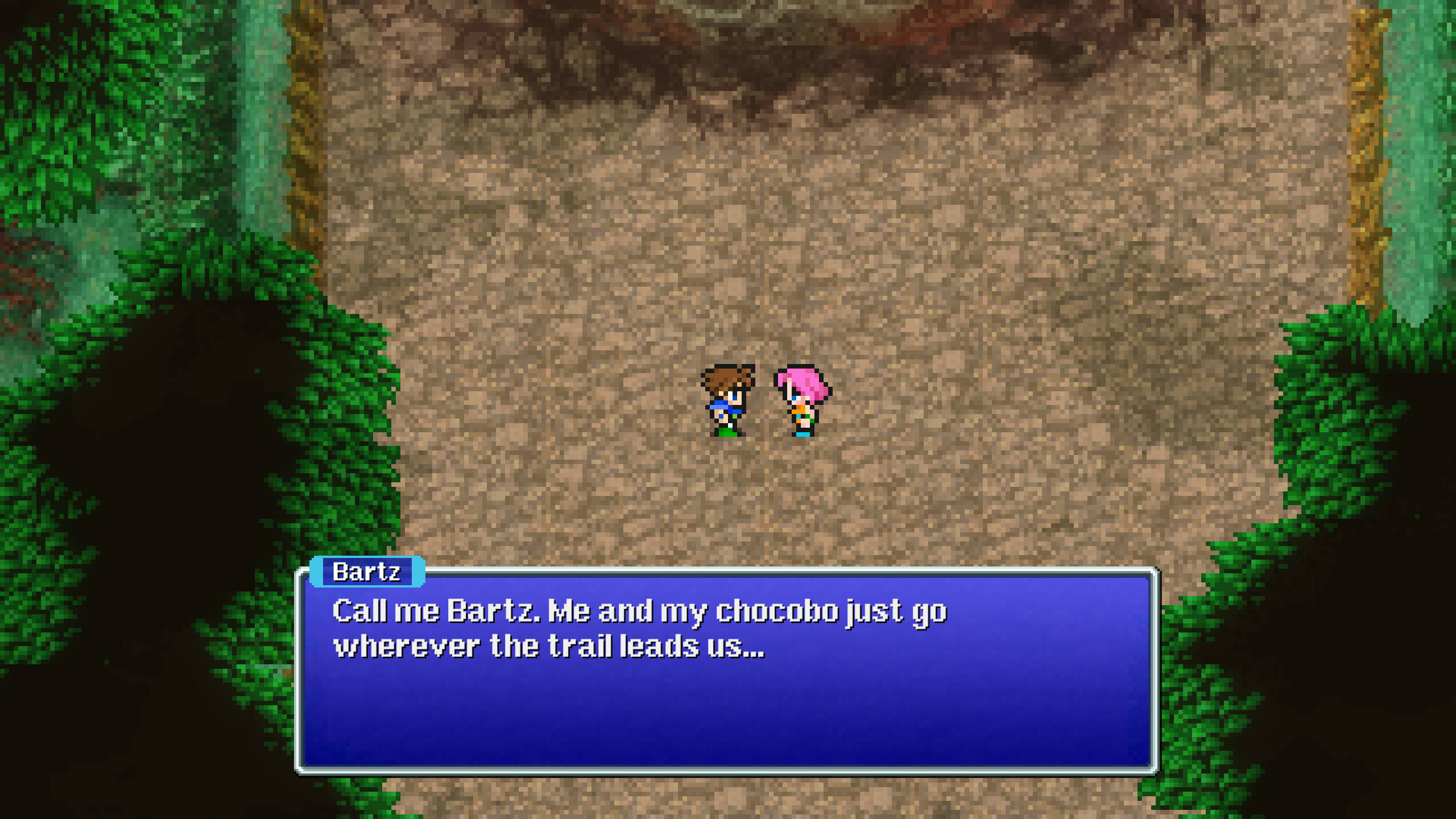



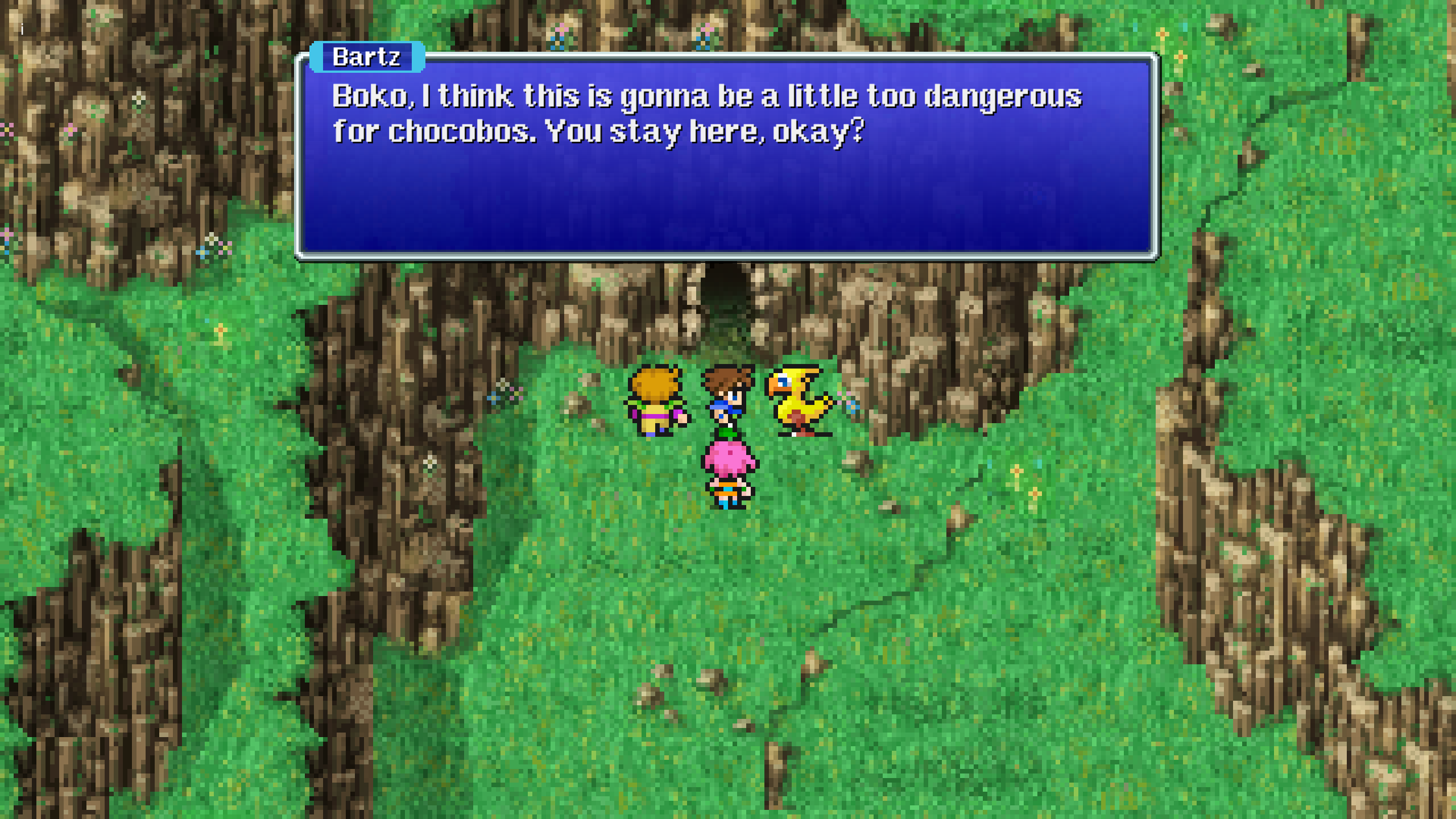


















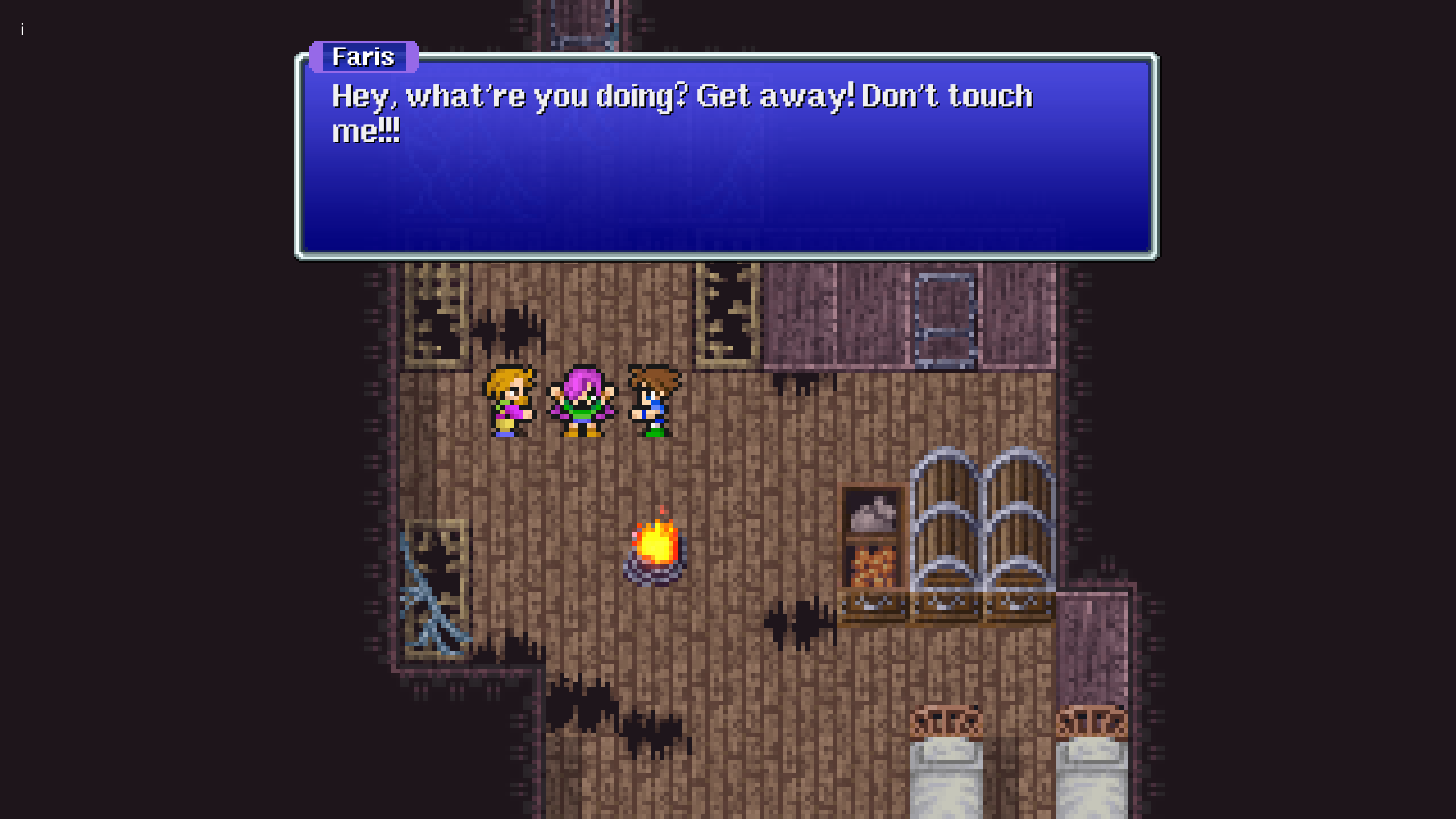


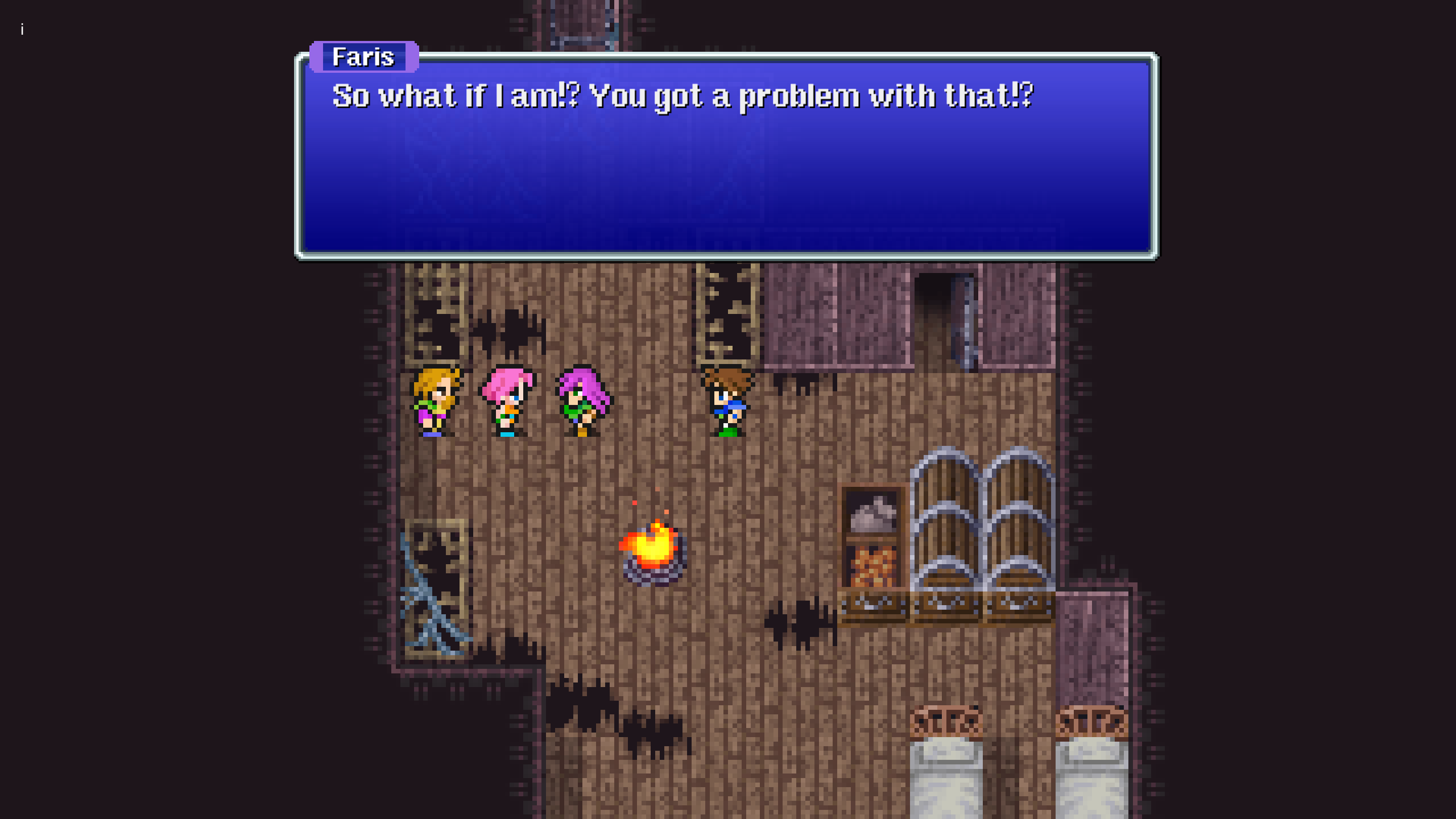






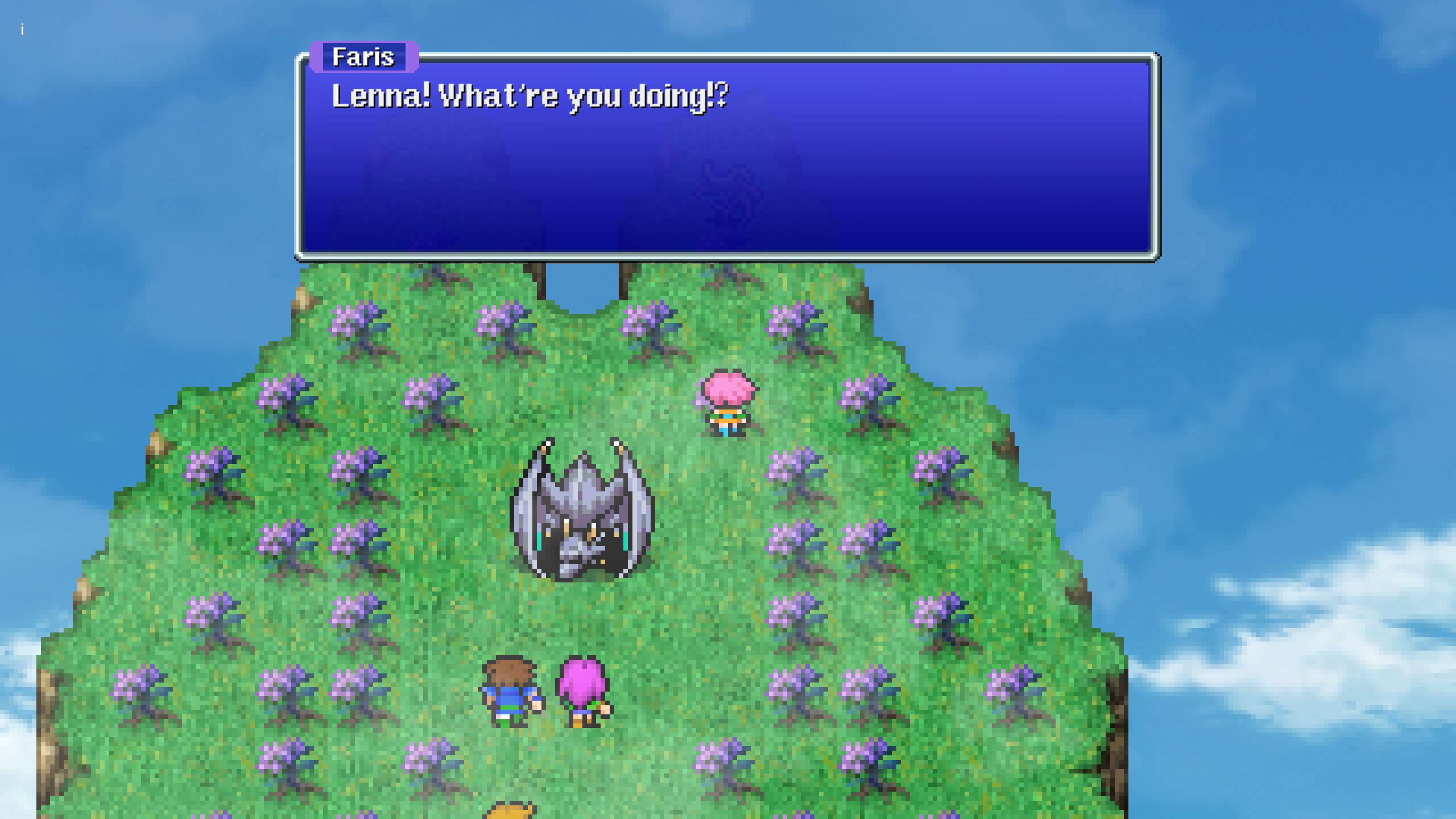


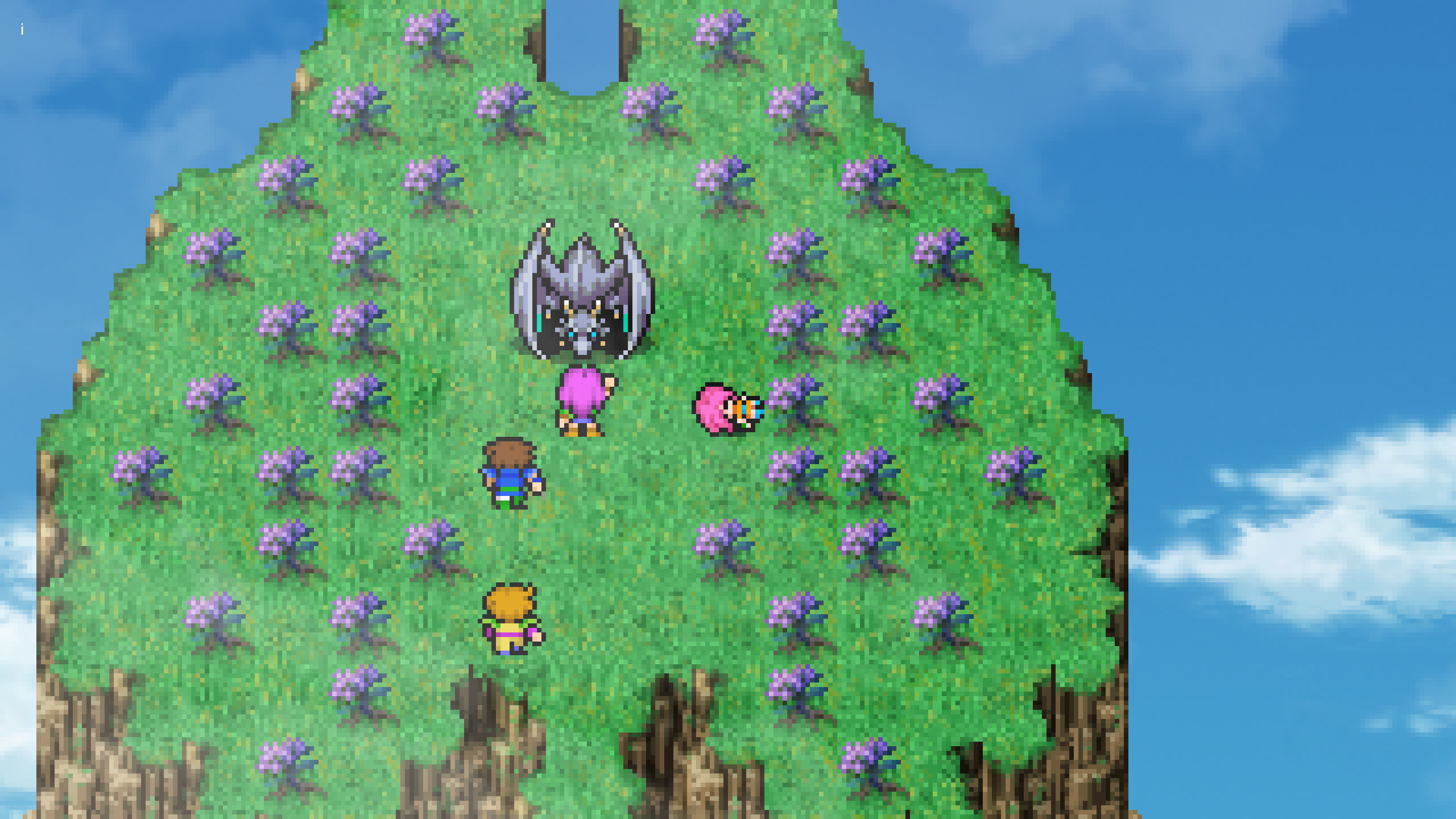






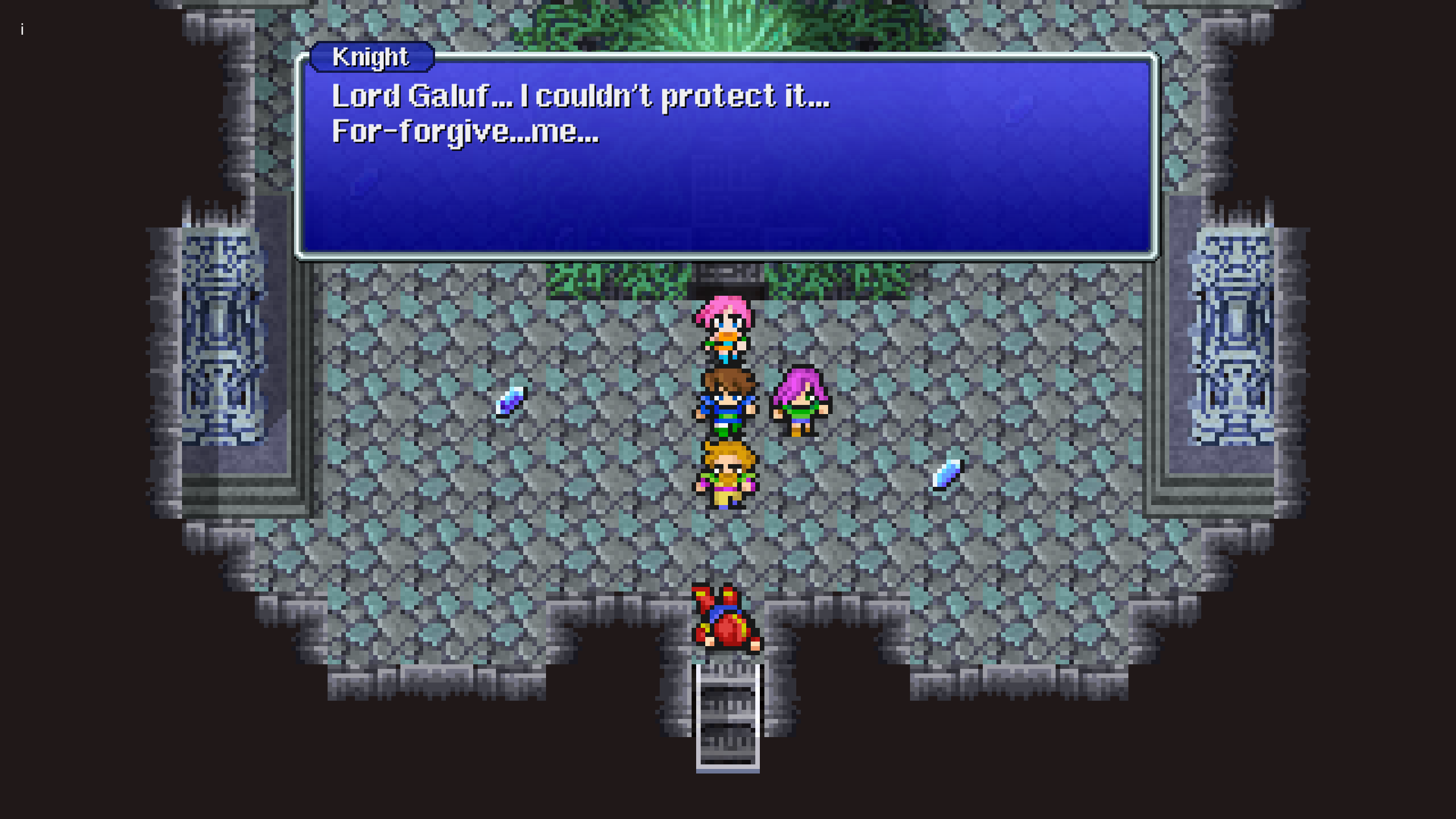

















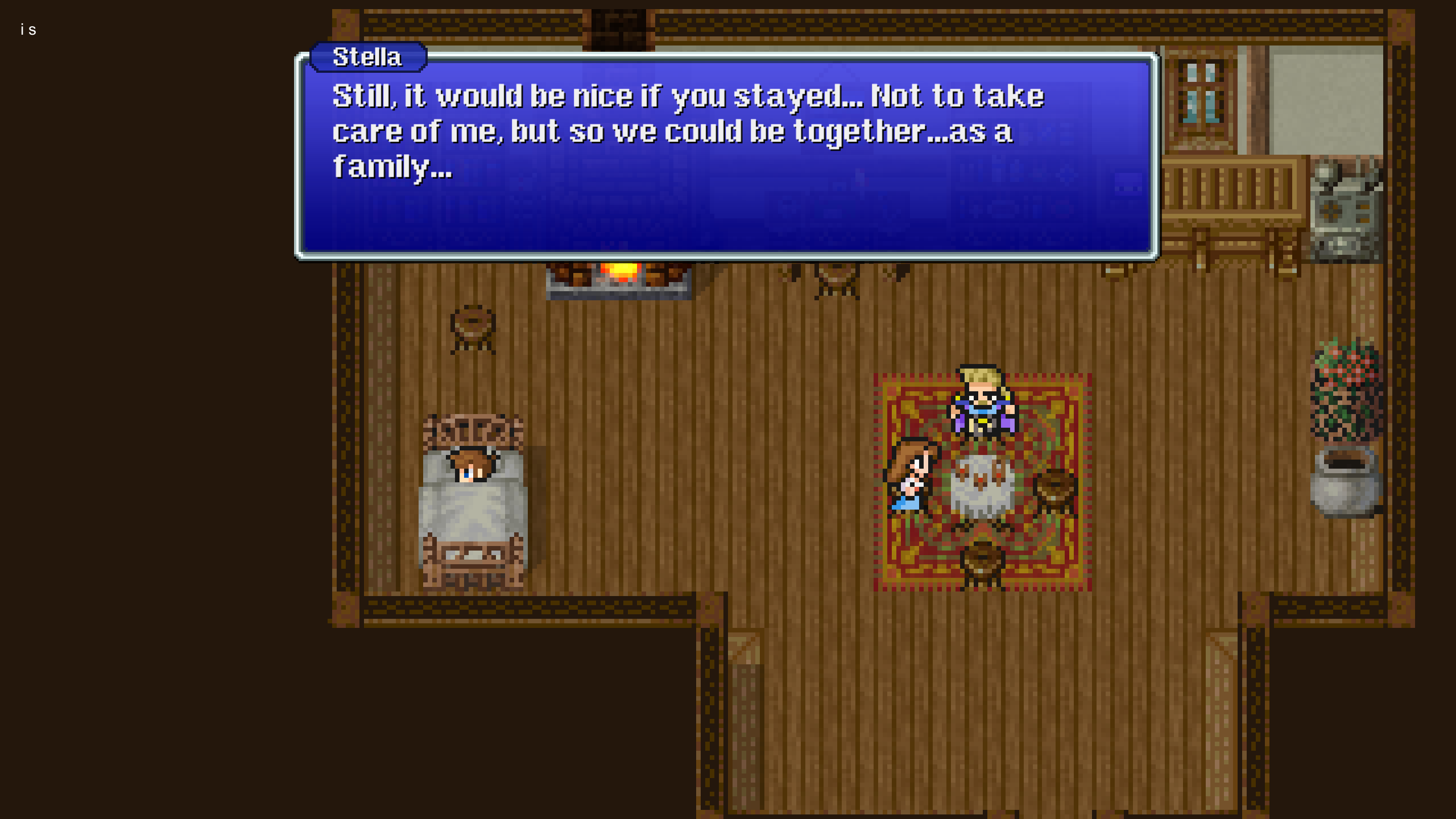


















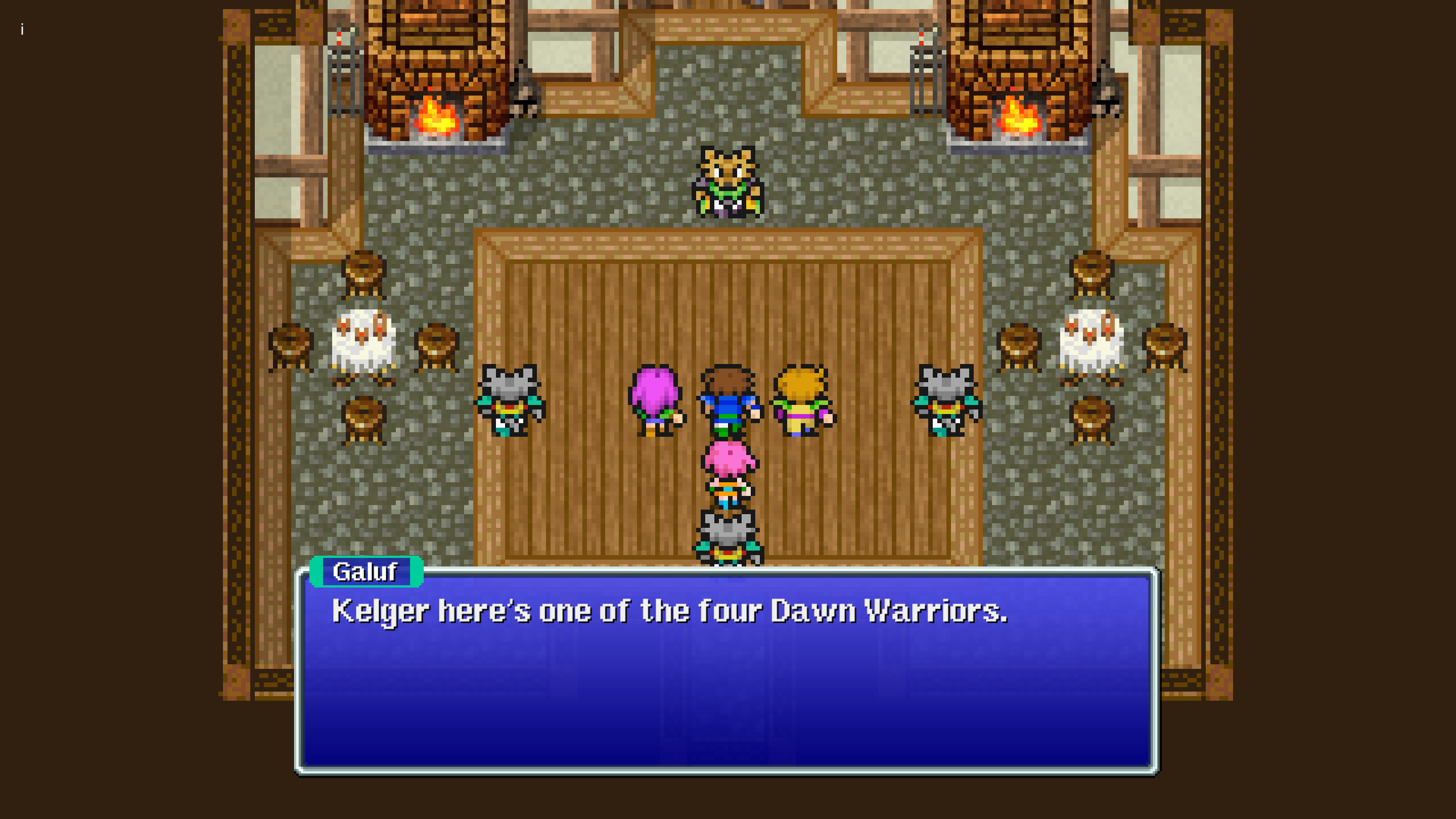





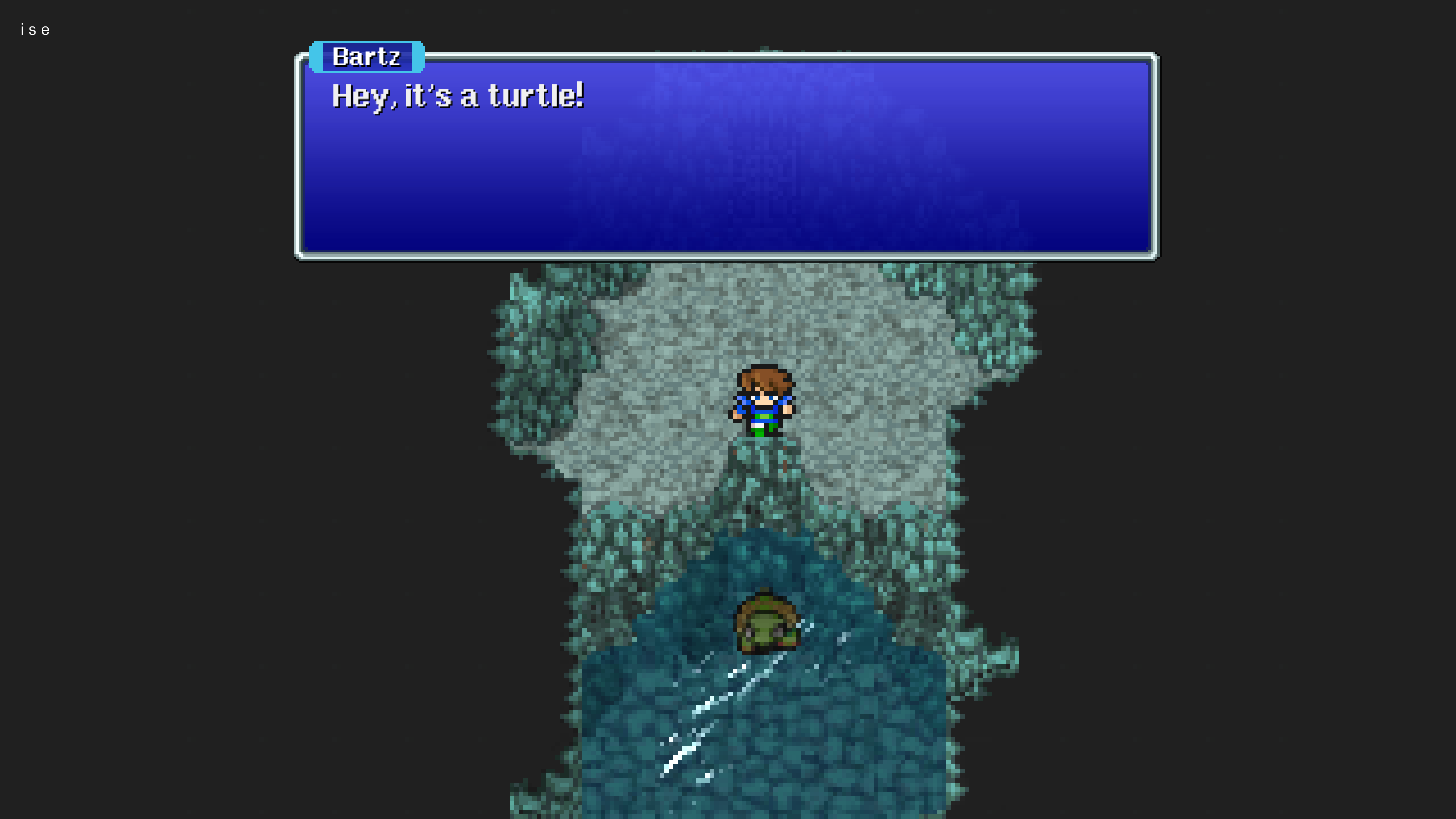















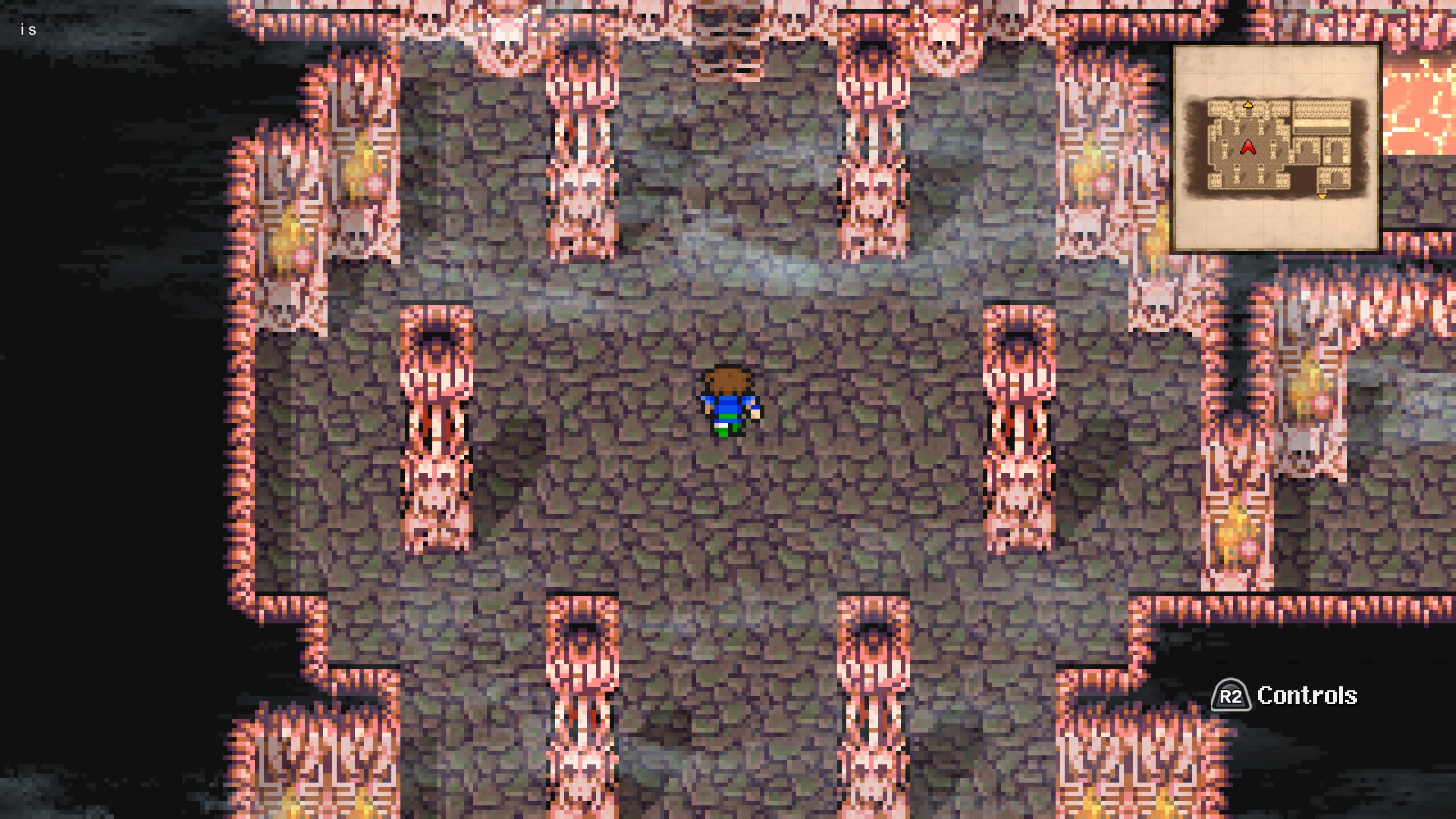

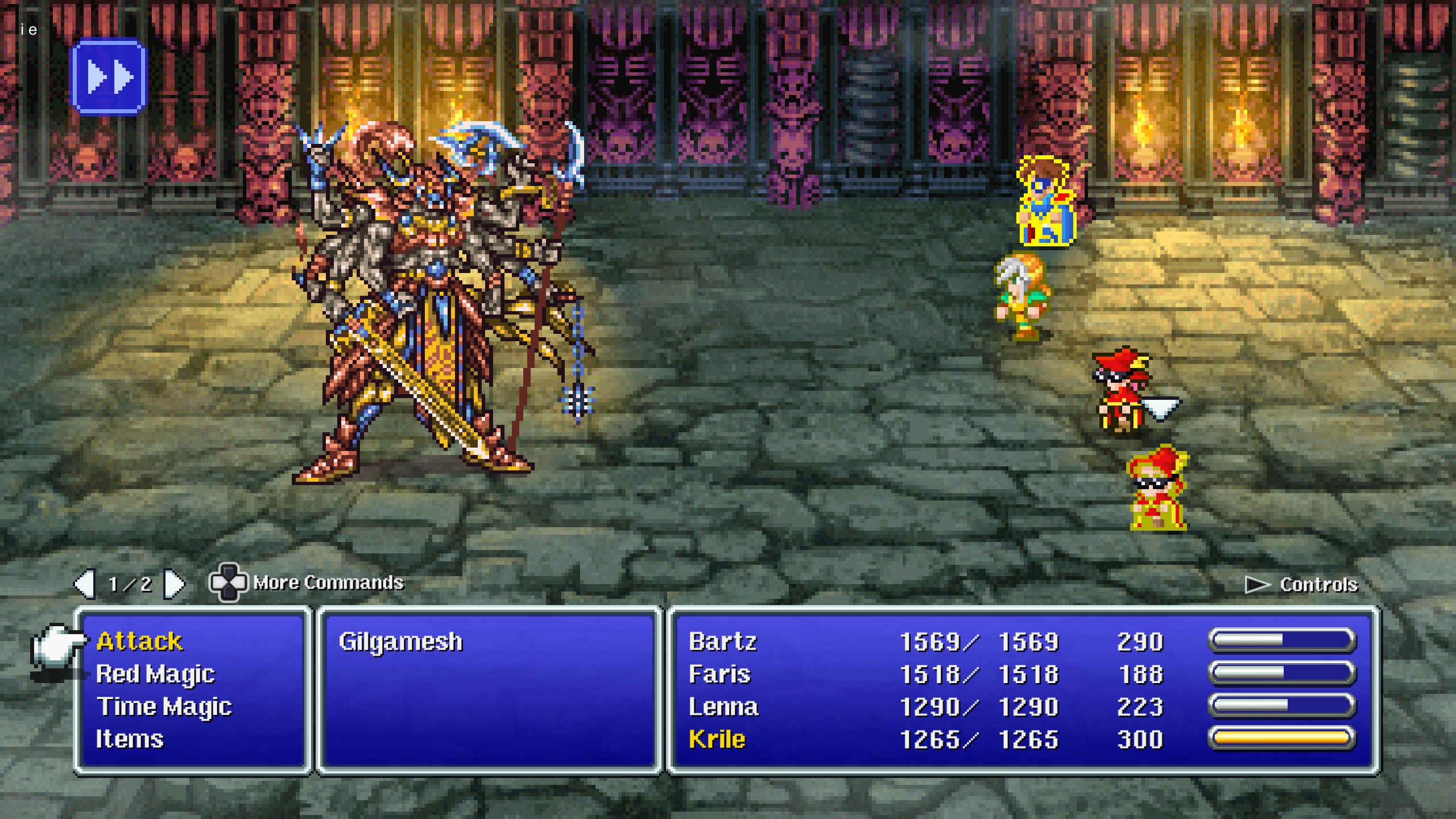




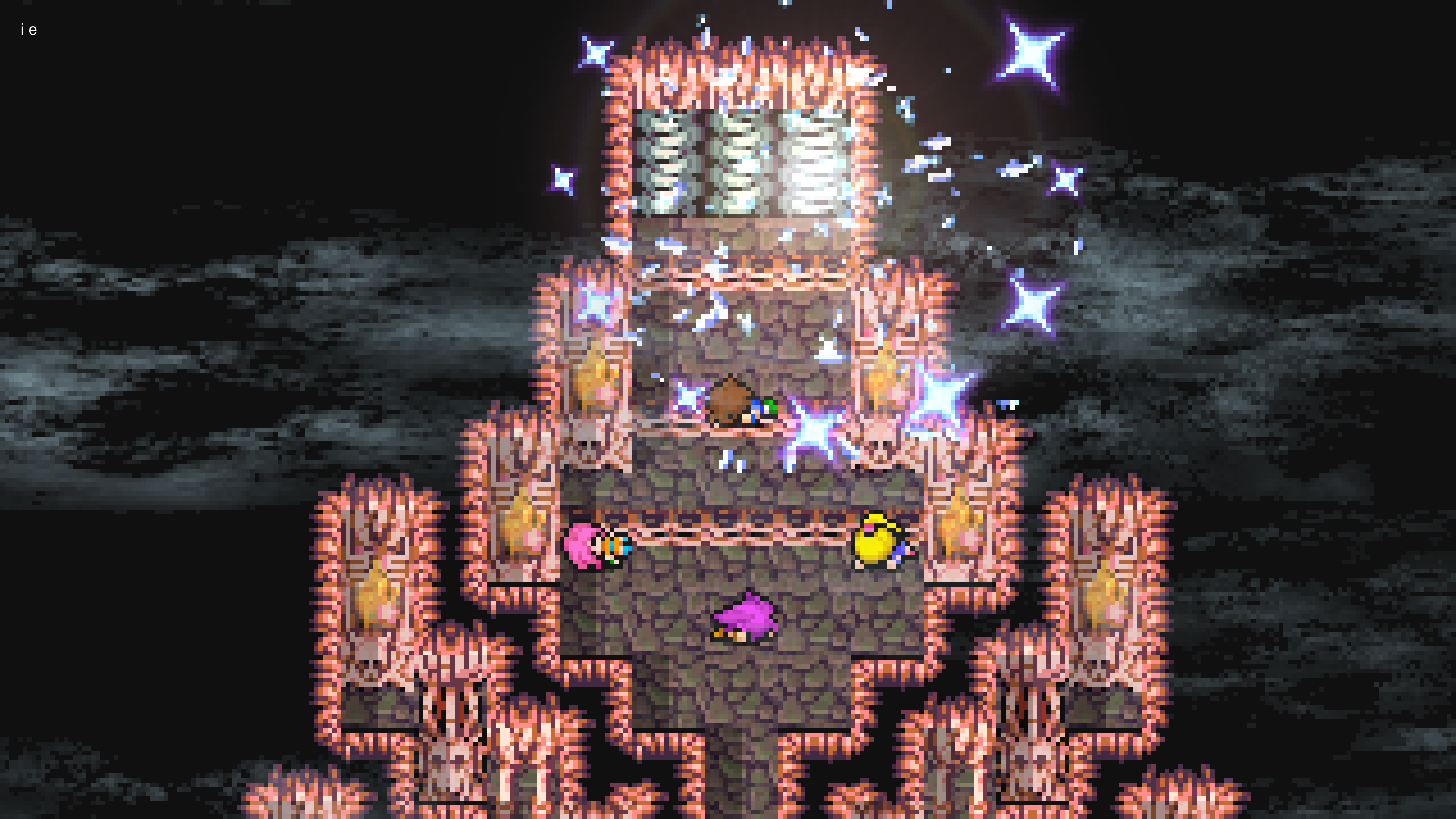

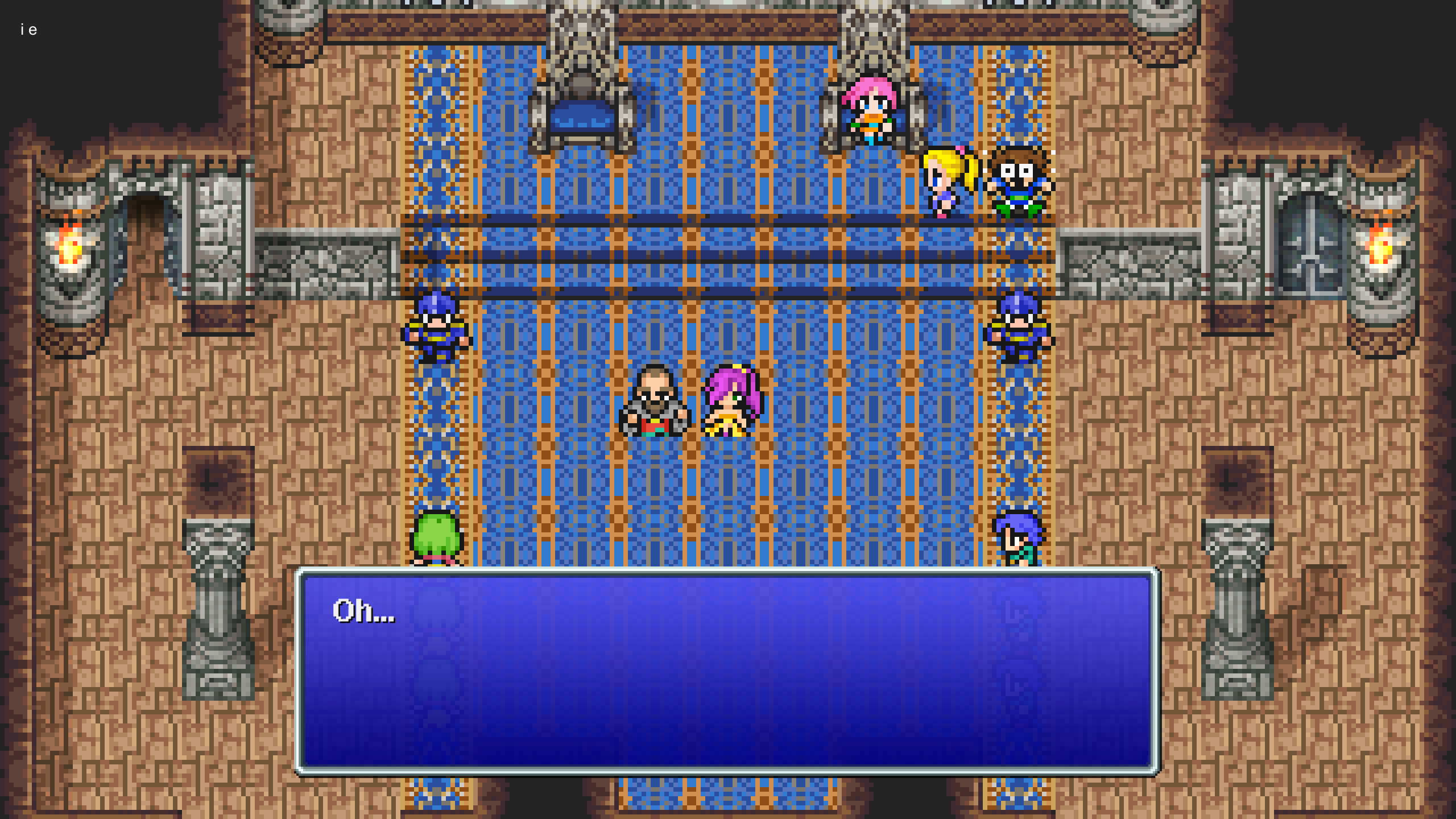






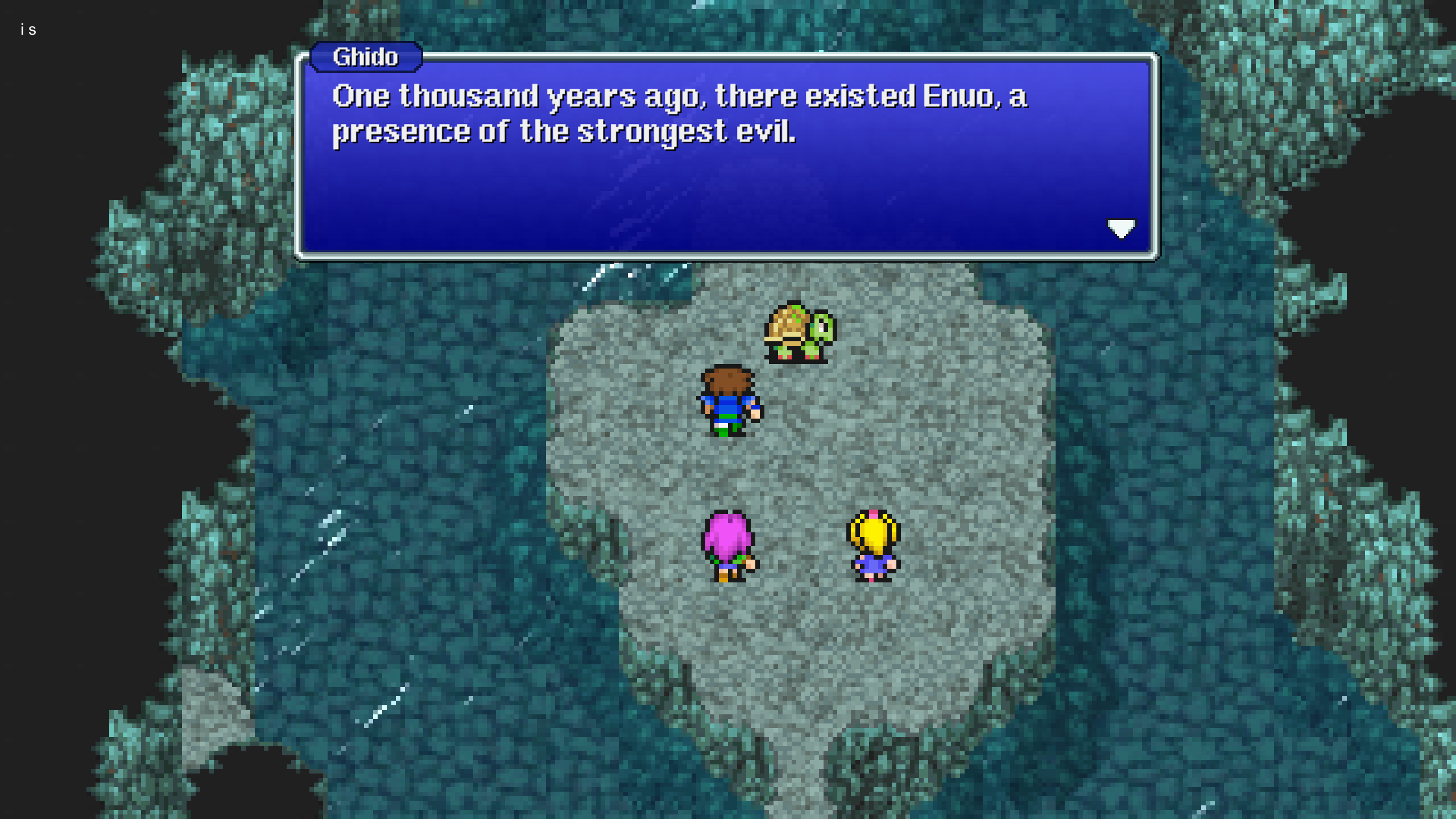








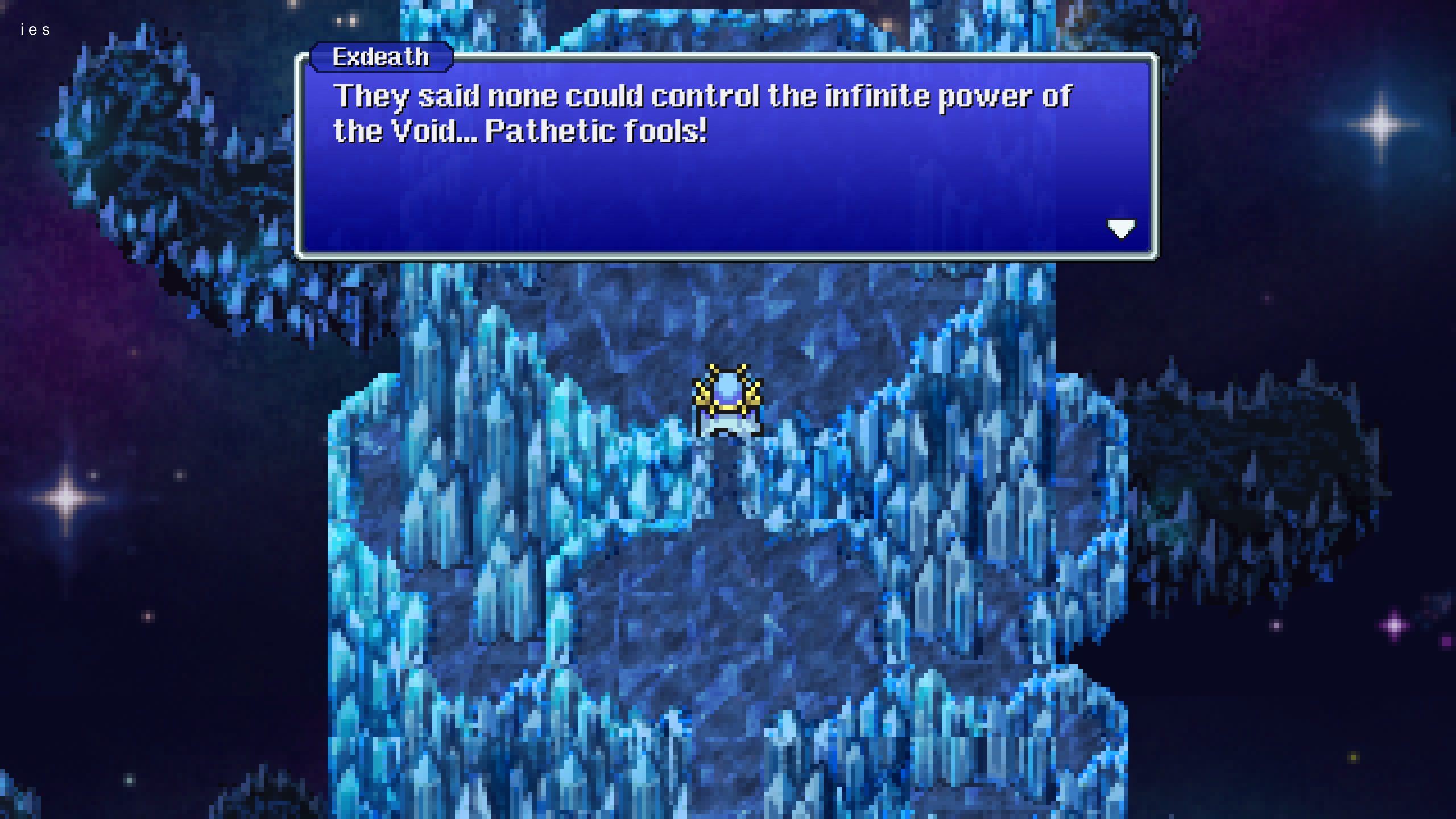



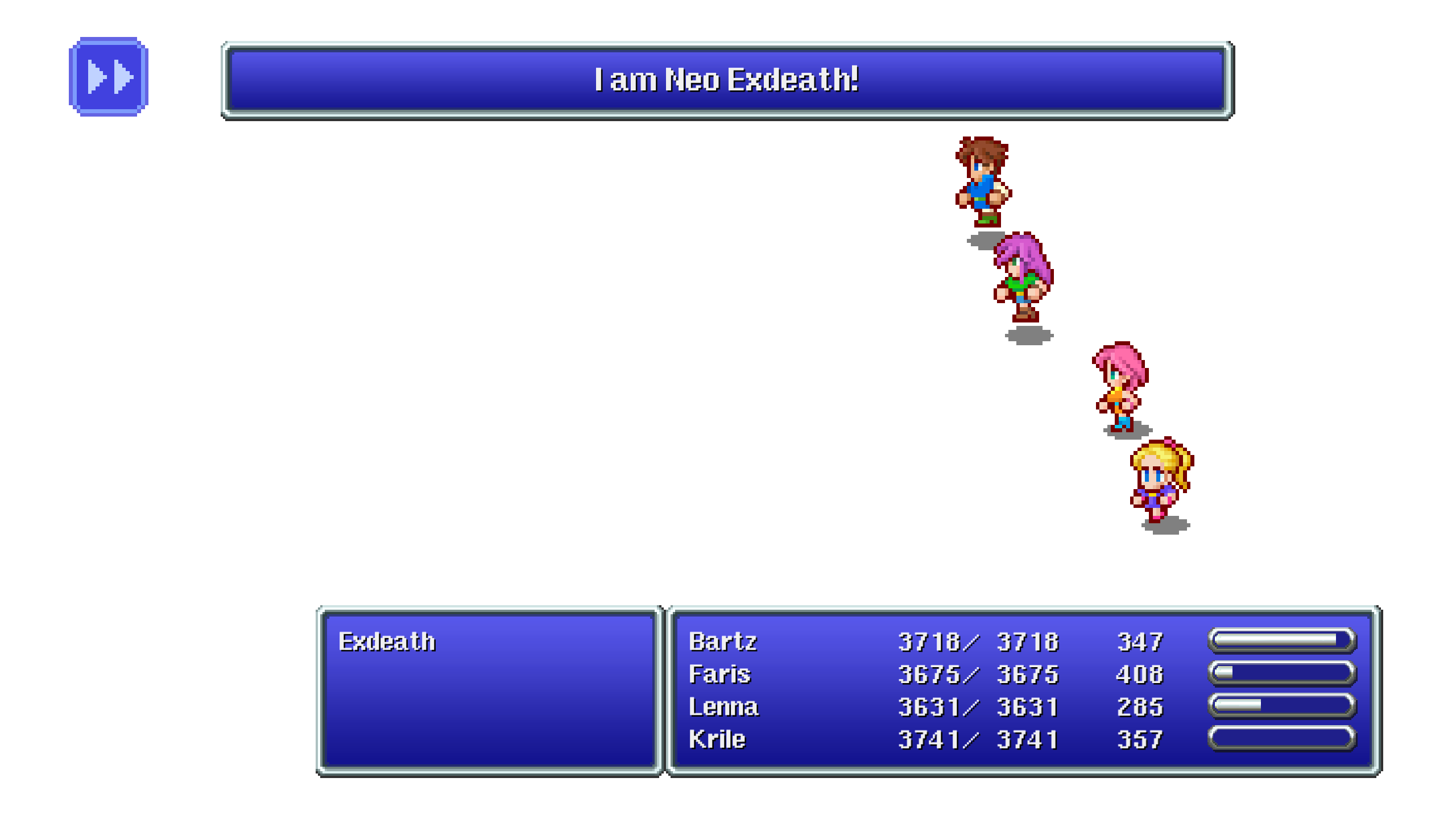













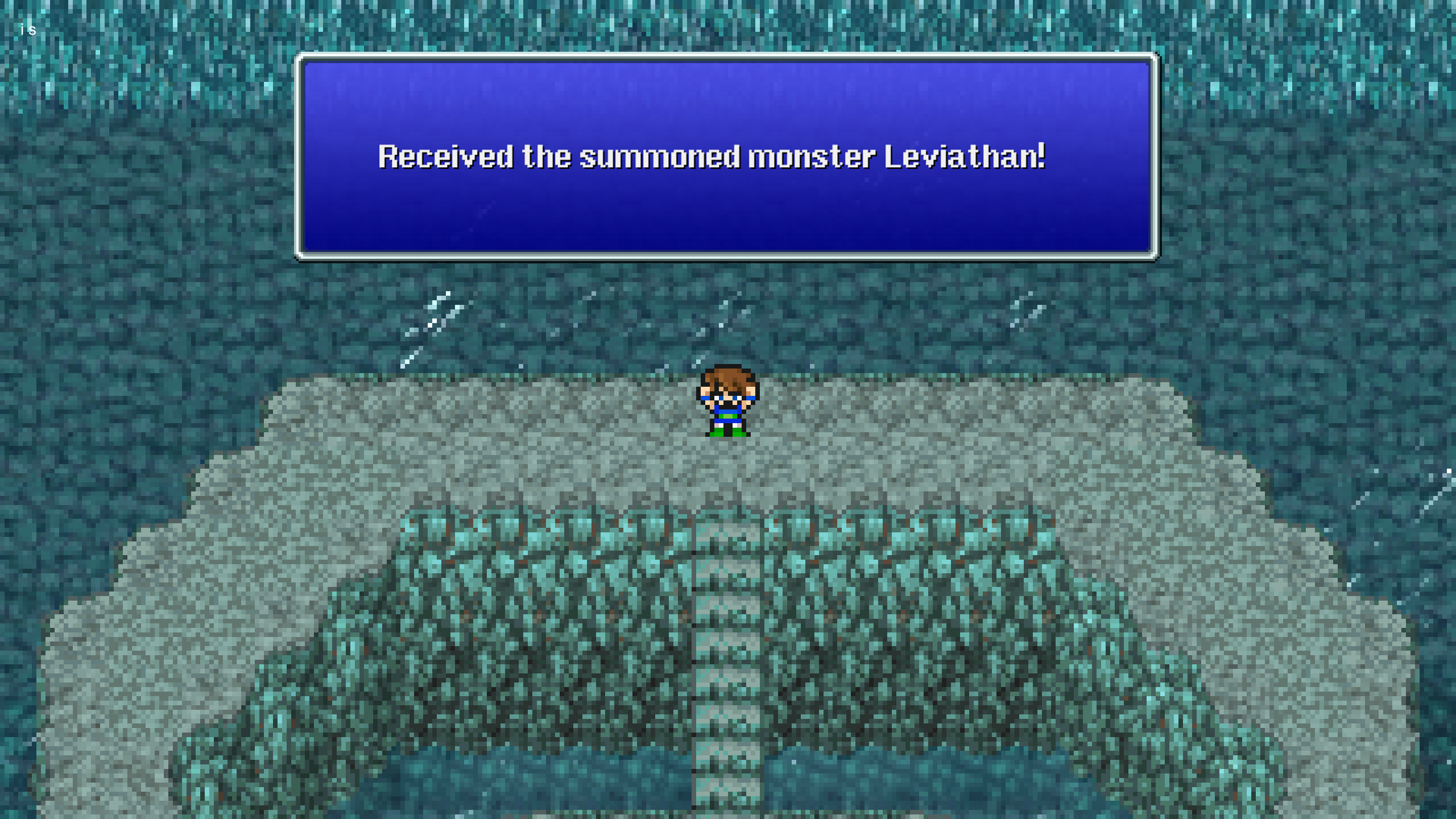


























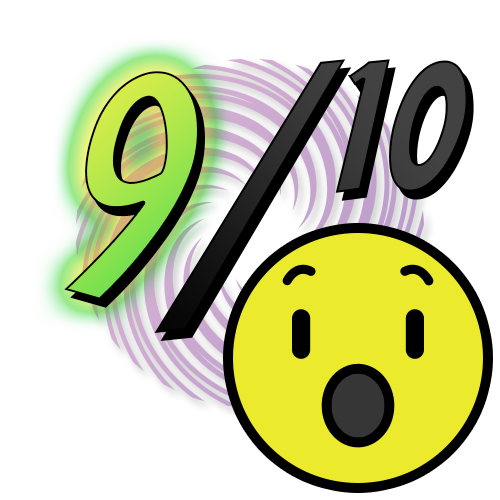



Leave a Reply